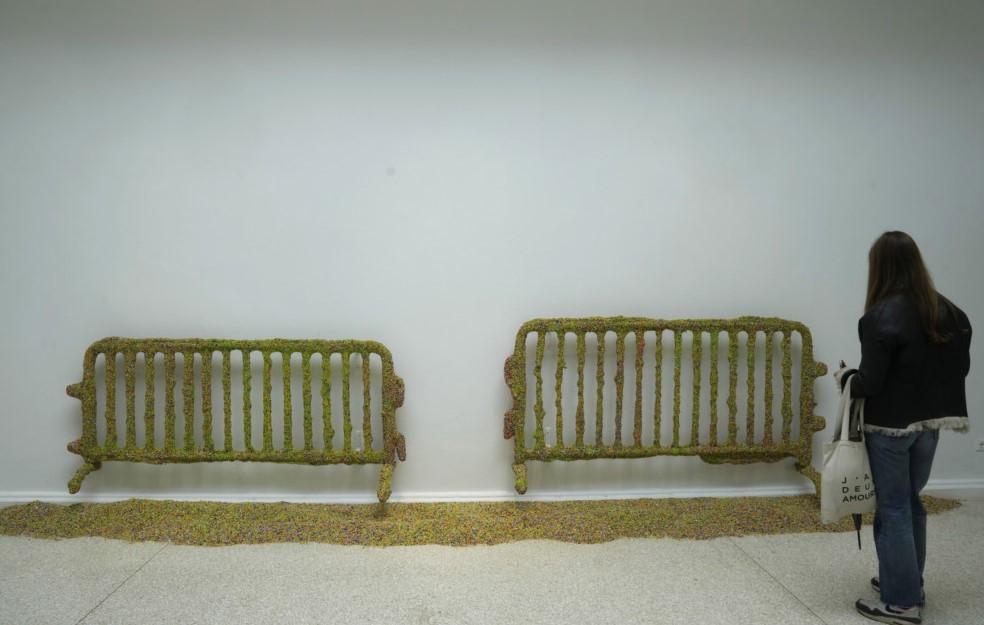
Scottish-Ghanaian architect Lesley Lokko is giving a platform to voices that have long been silenced at this year’s Venice Architecture Biennale, which opened on May 20, the first ever curated by an African, featuring a preponderance of work by Africans and the African diaspora.
The 18th architectural Biennale, titled “The Laboratory of the Future,” explores decolonization and decarbonization, topics about which Africans have much to say, Lokko said, citing the long exploitation of the continent for both human and environmental resources.
“The Black body was Europe’s first unit of energy,” Lokko told The Associated Press. “We have had a relationship to resources since time immemorial. We operate at a place where resources are not stable. They are also often fragile.
They’re often exploited. Our relationship to them is exploitative.”
Lokko tapped global stars like David Adjaye and Theaster Gates among 89 participants in the main show, more than half of them from Africa or the African diaspora. To reduce the Biennale’s carbon footprint, Lokko encouraged the participating architects, artists and designers to be as “paper-thin” as possible with their exhibits, resulting in more drawings, film and projections as well as the reuse of materials from last year’s contemporary art Biennale.
It is a fair question why an African-centric exhibition has been so long in coming to such a high-profile, international platform like Venice.
Okwui Enwezor, the late Nigerian art critic and museum director, was the first African to head the Venice Biennale contemporary art fair, which alternates years with the architectural show, in 2015. Lokko was the first Biennale curator selected by President Roberto Cicutto.
Impediments in the West to inclusive events with a focus on the global south were evident in the refusal by the Italian embassy in Ghana to approve visas for three of Lokko’s collaborators, which Lokko decried this week as “an old and familiar tale.”
A refocusing of the North-South relationship is suggested in the main pavilion’s facade: A corrugated metal roof cut into deconstructed images of the Venetian winged lion. The material is ubiquitous in Africa and other developing regions, and here offers free shade. The lion, native to Africa and for centuries a symbol of Venice, serves as a reminder of how deeply cultural appropriation runs.
Inside, Adjaye’s studio exhibits architectural models created “outside the dominant canon,” like the Thabo Mbeki Presidential Library in South Africa that takes inspiration from pre-colonial buildings. Ghanaian artist Ibrahim Mahama explores the colonial exploitation in the installation, “Parliament of Ghosts.”
And Olalekan Jeyifous, a Brooklyn-based Nigerian national, creates a sprawling retro-futuristic narrative around the fictional formation of a united African Conservation Effort, something he imagines would have been constructed a decade after African decolonization in an alternative 1972.
The Golden Lion for the best participant in the main show went to Alessandro Petti and Sandi Hilal for their exhibit DAAR, exploring the legacy and reuse of fascist colonial architecture.
More than in previous editions, the 64 national participants responded to Lokko’s themes with pavilions that found a natural echo with the main show and its focus on climate change issues and an expanded, more-inclusive dialogue.
Denmark offered practical solutions for coastal areas to work with nature to create solutions to rising seas, proposing Copenhagen islands that invite the sea in to form canals, not unlike Venice’s. The strategy contrasts with Venice’s own underwater barriers, which, underscoring the urgency of the issue, had to be raised during the Biennale preview week outside the usual flood season and for the first time ever in May.
Decolonization was a natural theme at the Brazilian pavilion, where curators Gabriela de Matos and Paulo Tavares show the architectural heritage of indigenous and African Brazilians, and challenge the “hegemonic” narrative that the capital, Brasilia, was built in the “middle of nowhere.” Their exhibit, titled “Terra,’’ was awarded the Golden Lion for the best national participant.
The U.S. Pavilion looked at ubiquitous plastic, invented and propagated in the United States, and how to cope with its durability, under the title “Everlasting Plastic.”
Ukraine returns to the Biennale with two installations that, in the gentlest possible way, serve as a reminder that war continues to rage in Europe. The pavilion in the Arsenale has been decked out in black-out materials to represent ad-hoc, if futile protective measures ordinary Ukrainians are taking against the threat of Russian bombardment.
In the center of the Giardini, curators Iryna Miroshnykova, Oleksii Petrov and Borys Filonenko have recreated earthen mounds that served as barriers against 10th century invaders. Though long abandoned, overtaken by modern farming and sprawl, they proved effective against Russian tanks last spring.